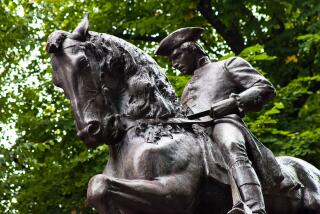Patriotic Quilts: a Patchwork Collection of Pride and Turmoil
Patriotic quilts are among the most exquisite examples of Americaâs long quilting heritage, and todayâs collectors pay $500 to $2,000 or more for those made before 1950.
Dubbed patriotic quilts because of their symbolic colors and motifs, Marie Proeller wrote in a recent article in Country Living, they tell the story of the nationâs history and capture the pride of its people.
âThere is a strong tradition of patriotic textiles in the United States,â said Elizabeth V. Warren, consulting curator at the Museum of American Folk Art in New York City. âWhether made in the 19th century or in our own, these textiles have allowed American women to express their political feelings and their support for their country.â
Not long after the American Revolution, European textile manufacturers began to produce fabrics featuring images associated with the new Republic--including George Washington and Benjamin Franklin. American needleworkers enthusiastically bought them for use in all forms of craft work, including the first patriotic quilts, or Liberty quilts.
As America grew, so did the symbols available to the quilter. The American flag, adopted in 1777, was followed by the bald eagle in 1782 and a long line of statesmen in the years after that.
âQuilt makers were always looking for good graphic images,â Warren said. âAnd they found them in patriotic motifs, especially in the American flag.â
*
Quilters chronicled Americaâs wars, elections, struggles and celebrations. One can trace westward expansion in the pioneer quilts made to commemorate the adoption of each new state. The growth of technology was recorded in 20th century quilts featuring cars, airplanes, even skyscrapers.
During the Civil War, patriotic quilting was widespread. Aid societies and quilting bees abounded as women on both sides made fund-raising quilts as well as clothes and warm bedcovers.
The Union Army Encircled Star appeared for the first time in the North, while the Southâs intricate white work became known as Secession quilts.
Though people made hundreds of thousands of quilts during the Civil War, the textiles received heavy use, making surviving examples rare and extremely valuable.
Patriotic quilting reached another peak of popularity around the 1876 centennial. Commemorative handkerchiefs from that yearâs Philadelphia exposition were often incorporated into quilts, as were the dates 1776-1876. Centennial quilts existed for show, so many survive today in near-perfect condition.
Though quilting as a mainstream activity declined in the 20th century, patriotic examples continue to appear regularly at times of national strife and celebration, including the Century of Progress quilts created for the 1933 Chicago Worldâs Fair and the victory quilts made at the end of World War II.
*
The 1976 bicentennial inspired one of this centuryâs biggest quilting revivals, and patriotic themes proliferated. In the years since, American quilters have continued to commemorate such events as the Statue of Libertyâs 1986 centennial and the Persian Gulf War.
âThe urge to commemorate the events of oneâs lifetime is a natural tendency for many people,â said Diane L. Fagan Affleck, senior curator at the Museum of American Textile History, currently renovating a new site in Lowell, Mass.
âItâs fun for us to see that we share feelings with people in times other than our own.â
Although the latter half of the 20th century has produced many wonderful patriotic quilts, they do not often show up in the greater quilt market.
âAlthough contemporary quilts hold a strong emotional attachment for their makers and local significance for their communities,â Warren said, âthe market for them does not compare to the antique quilt market--yet.â
More to Read
The biggest entertainment stories
Get our big stories about Hollywood, film, television, music, arts, culture and more right in your inbox as soon as they publish.
You may occasionally receive promotional content from the Los Angeles Times.










